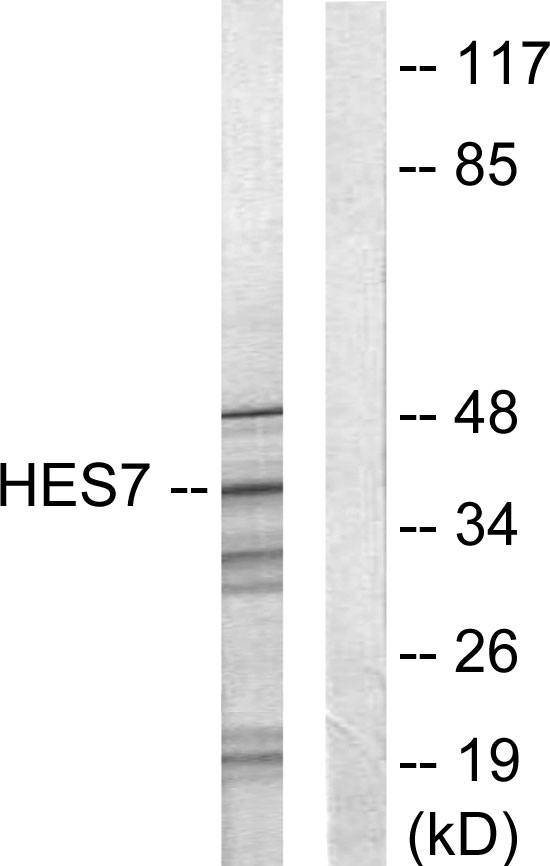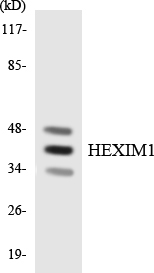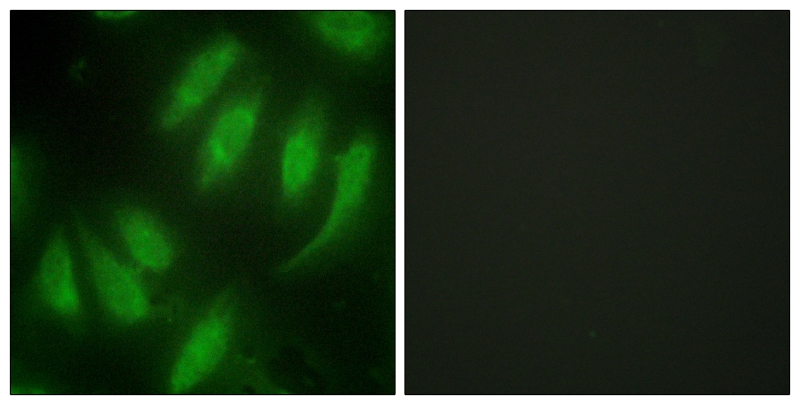



| WB | 1/500-1/1000 | Human,Mouse,Rat |
| IF | 咨询技术 | Human,Mouse,Rat |
| IHC | 1/50-1/100 | Human,Mouse,Rat |
| ICC | 1/50-1/200 | Human,Mouse,Rat |
| FCM | 咨询技术 | Human,Mouse,Rat |
| Elisa | 1/10000 | Human,Mouse,Rat |
| Aliases | CLP1; EDG1; HIS1; MAQ1 |
| Entrez GeneID | 10614 |
| WB Predicted band size | Calculated MW: 41 kDa; Observed MW: 41 kDa |
| Host/Isotype | Rabbit IgG |
| Antibody Type | Primary antibody |
| Storage | Store at 4°C short term. Aliquot and store at -20°C long term. Avoid freeze/thaw cycles. |
| Species Reactivity | Human,Mouse,Rat |
| Immunogen | The antiserum was produced against synthesized peptide derived from human HEXIM1. AA range:181-230 |
| Formulation | Purified antibody in PBS with 0.05% sodium azide,0.5%BSA and 50% glycerol. |
+ +
以下是关于HEXIM1抗体的3篇参考文献,涵盖其功能研究及实验应用:
---
1. **文献名称**: "HEXIM1 is a promiscuous regulator of transcriptional networks required for the control of cellular growth and differentiation"
**作者**: Michels et al.
**摘要**: 本研究揭示了HEXIM1通过调控P-TEFb复合物的活性,参与细胞增殖与分化的转录暂停机制。研究使用HEXIM1抗体进行免疫共沉淀(Co-IP)和染色质免疫沉淀(ChIP),证实其在抑制RNA聚合酶II介导的转录延伸中的关键作用,并提示其在癌症中的潜在调控功能。
---
2. **文献名称**: "Regulation of HEXIM1 stability and transcription elongation by the ubiquitin-proteasome system"
**作者**: Chao & Price
**摘要**: 该文献阐明了HEXIM1蛋白稳定性与泛素-蛋白酶体系统的关联,发现其与P-TEFb的结合可抵抗蛋白酶体降解。通过Western blot和免疫荧光实验(使用HEXIM1特异性抗体),作者证明HEXIM1的磷酸化状态直接影响其在细胞核内的定位及转录抑制功能。
---
3. **文献名称**: "HEXIM1 downregulation promotes tumor progression via NF-κB signaling in triple-negative breast cancer"
**作者**: Huang et al.
**摘要**: 本文发现三阴性乳腺癌中HEXIM1表达降低与NF-κB通路异常激活相关。利用HEXIM1抗体进行免疫组织化学(IHC)分析临床样本,结果显示HEXIM1低表达患者预后较差,提示其作为潜在肿瘤抑制因子及治疗靶点的价值。
---
**备注**:以上文献信息基于领域内典型研究方向整理,实际引用时建议通过PubMed或Google Scholar核对标题、作者及摘要准确性。
The HEXIM1 (Hexamethylene Bisacetamide Inducible Protein 1) antibody is a tool used to study the HEXIM1 protein, a key transcriptional regulator involved in RNA polymerase II (Pol II) pause-release mechanisms. HEXIM1. originally identified as a protein induced by hexamethylene bisacetamide, forms a complex with 7SK small nuclear RNA (7SK snRNA) and the positive transcription elongation factor b (P-TEFb). This interaction inhibits P-TEFb’s kinase activity, which is essential for transitioning Pol II from a paused to an elongation-competent state, thereby modulating gene expression. HEXIM1 plays roles in cellular processes like differentiation, apoptosis, and stress response, and its dysregulation is linked to cancers, cardiovascular diseases, and HIV latency.
Antibodies targeting HEXIM1 are widely employed in research to investigate its expression, localization, and interactions via techniques such as Western blotting, immunoprecipitation, and immunofluorescence. They help elucidate HEXIM1’s regulatory functions in transcriptional control and its involvement in diseases. Commercial HEXIM1 antibodies are typically raised in rabbits or mice, with specificity validated against recombinant proteins or knockout controls. Studies using these antibodies have advanced understanding of dynamic P-TEFb/HEXIM1/7SK snRNA complexes and their impact on global transcription, making HEXIM1 antibodies critical for exploring gene regulation pathways and therapeutic targets.
×